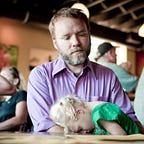You might think with your brain, but your brain thinks with its gut
Jonah Lehrer explains how every decision you make enters your brain through the emotional door and exits through the rational door.
At the end of his book “How We Decide,” the once pop-science boy wonder Jonah Lehrer tells a story about the conundrum of buying Cheerios. He couldn’t decide between Honey Nut and Apple Cinnamon, and it was this weekly grocery struggle that inspired him to research the neuroscience of decision-making. Lehrer would eventually shoot his career in the foot, but before any shots were fired he did make some important points about how we make up our mind.
Since Descartes, the Western world has run with the idea that there are two very different types of decisions: decisions that come from the gut, like whether you want chocolate or strawberry ice cream; and decisions that come from the head, like which home equity loan is right for you. The truth is, even when we believe we’re thinking with our brain, our brain is thinking with its gut.
Here’s how Lehrer describes what happens when there is a choice to be made: The emotional side of the brain jumps into action first, making a decision in a split second before the rational side chimes in with the why. As he puts it, “It’s only at this point — after the emotions have already made the moral decision — that those rational circuits in the prefrontal cortex are activated.”
To look at it another way, picture your brain as a house. Upstairs, there’s a grad student constantly on deadline, scribbling away in his bedroom, oblivious to what’s going on downstairs. Meanwhile, at the bottom of the stairs sits a monkey in a lounge chair, waiting to answer the door when a decision comes calling.
Whoever knocks on that door, whatever choice there is to be made, it’s the monkey that opens the door. It’s only after he’s shaken hands and taken possession of the merchandise that he clambers upstairs and tells the grad student which silverware set he bought. Sometimes, if the choice is a tough one — like deciding on a mutual fund or car loan — he might do a quick check-in upstairs before signing on the dotted line. But don’t count on it.
And that’s how it works for everyone, in every situation — whether it’s a head chef deciding whether she wants to put sturgeon or salmon on the menu, a runner buying a new pair of shoes, or the head of a division allocating a multimillion-dollar budget. In every choice we make — big or small — it’s the monkey that calls the shots, with an optional consult from the grad student.
For those trying to make difficult decisions, Lehrer’s advice is to make sure your monkey and grad student have actually talked it over before you click the buy button or sign the contract. For those trying to influence someone else’s decision, whether you’re a parent trying to talk the kids into going to bed or a broker trying to persuade a client to choose the right investment vehicle, the monkey always calls the shots.
